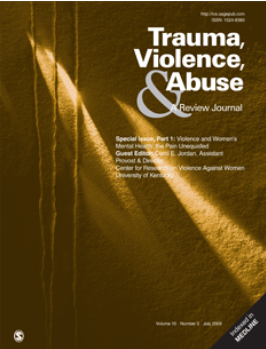Childhood Emotional Maltreatment and Substance Use in Adolescents: A Mini Multilevel Meta-Analytical Review
IF 5.4
1区 社会学
Q1 CRIMINOLOGY & PENOLOGY
引用次数: 0
Abstract
This meta-analysis examines the association between childhood emotional maltreatment (CEM) and substance use, utilizing a multilevel meta-analytic approach to address the complexity of multiple effect sizes across studies. CEM, often perpetrated by family members or caregivers, is a significant predictor of various negative outcomes, including substance use, yet the variability in study designs, participant characteristics, and outcome measures has made it challenging to establish a clear relationship. By employing a multilevel model, this analysis captured variances both between and within studies, accounting for sampling differences and enhancing the precision of effect size estimates. Data from 6 studies, involving 7,624 participants (41.07% female, mean age 15.88), were analyzed. The studies, which used cross-sectional designs and assessed CEM using the Childhood Trauma Questionnaire, highlighted substance use issues, such as alcohol and cannabis consumption, among CEM-affected populations. Random-effects models were used throughout, and moderators, including participant demographics, type of CEM, and substance use, were explored to explain variability in findings. Results revealed significant heterogeneity, which was quantified using the I² statistic, and sensitivity analyses confirmed the robustness of the findings. This multilevel approach provided a more comprehensive understanding of the relationship between CEM and substance use, emphasizing the need for targeted interventions that address the specific role of childhood emotional abuse in adolescent substance use vulnerability.儿童情感虐待与青少年物质使用:一项小型多水平荟萃分析综述
本荟萃分析考察了儿童情感虐待(CEM)与物质使用之间的关系,利用多层次荟萃分析方法来解决研究中多重效应大小的复杂性。CEM通常由家庭成员或照顾者实施,是各种负面结果(包括药物使用)的重要预测因子,但研究设计、参与者特征和结果测量的可变性使得建立明确的关系具有挑战性。通过采用多水平模型,该分析捕获了研究之间和研究内部的差异,考虑了抽样差异并提高了效应大小估计的精度。我们分析了6项研究的数据,涉及7624名参与者(41.07%为女性,平均年龄15.88岁)。这些研究采用了横断面设计,并使用儿童创伤问卷评估了CEM,强调了CEM影响人群中的物质使用问题,如酒精和大麻消费。随机效应模型贯穿始终,并探讨了调节因素,包括参与者人口统计学、CEM类型和物质使用,以解释研究结果的可变性。结果显示显著的异质性,使用I²统计量进行量化,敏感性分析证实了研究结果的稳健性。这种多层次的方法提供了对CEM和物质使用之间关系的更全面的理解,强调需要有针对性的干预措施,解决儿童情感虐待在青少年物质使用脆弱性中的具体作用。
本文章由计算机程序翻译,如有差异,请以英文原文为准。
求助全文
约1分钟内获得全文
求助全文
来源期刊

Trauma Violence & Abuse
Multiple-
CiteScore
13.60
自引率
7.80%
发文量
131
期刊介绍:
Trauma, Violence, & Abuse is devoted to organizing, synthesizing, and expanding knowledge on all force of trauma, abuse, and violence. This peer-reviewed journal is practitioner oriented and will publish only reviews of research, conceptual or theoretical articles, and law review articles. Trauma, Violence, & Abuse is dedicated to professionals and advanced students in clinical training who work with any form of trauma, abuse, and violence. It is intended to compile knowledge that clearly affects practice, policy, and research.
 求助内容:
求助内容: 应助结果提醒方式:
应助结果提醒方式:


